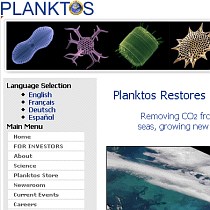-
(单词翻译:双击或拖选)
Miami
01 June 2007
Scientists are seeking new ways to reverse the build-up of carbon dioxide in the atmosphere, which many believe is the cause of global warming. VOA's Brian Wagner reports one U.S. project aimed at stimulating1 plankton2 growth in the oceans is raising some debate about its possible effectiveness.
 |
| Planktos website screenshot |
The U.S. firm Planktos is planning to revive plankton in several regions of the Pacific Ocean as an effective way to absorb atmospheric4 CO2 and counter global warming. Planktos climate expert Melodie Grubbs says iron is the key nutrient5 needed to stimulate6 plankton growth.
"Once we put that in, iron acts as a catalyst7 for photosynthesis8, which creates plankton," she said. "It's a missing nutrient in the ocean, and from that sparks a natural plankton bloom."
Researchers say plankton blooms are down, because less iron dust is being blown onto the ocean's surface by nutrient-rich winds. Planktos says dust supply has fallen 30 percent over the past 30 years, resulting in a 10 percent decline in plankton populations. The Planktos team hopes to reverse the trend by seeding the waters off the Galapagos Islands and several other spots in the Pacific Ocean.
Researchers have been studying the effects of iron seeding on carbon dioxide levels in the atmosphere for more than two decades. Frank Millero, professor of marine chemistry at the University of Miami, helped pioneer some of the techniques in the 1990s.
"Even at that time people were thinking about this as a solution," he said. "We were more interested in showing that [lack of] iron was limiting to plant growth."
The Planktos team says it is building on the research of Millero and other scientists. But unlike academics, the California firm hopes to get financing from major companies that release carbon dioxide into the atmosphere. The companies would compensate10 Planktos for reducing greenhouse gas emissions11 globally, without altering their own manufacturing process.
Planktos says it hopes to sell these so-called carbon credits or offsets12. Profits from the sales will create new opportunities for environmental restoration, says Planktos project manager Michael Bailey.
"We are part of the international carbon credit community, part of that marketing13 plan, basically trying to find a way to make money by restoring the oceans and the earth's atmosphere. So this is a beautiful business model," he said.
Experts, however, disagree on how much carbon dioxide is absorbed by plankton blooms, which tend to last no more than two or three weeks. Professor Millero says a key concern is whether plankton seeded with iron can have a long-term effect.
"The problem, if there is one, is if the carbon dioxide in the plant material does not sink to the deep waters and become oxidized there, then the net effect is not as large as you might hope for," he noted14.
Scientists say plankton has a positive impact on global warming only when carbon-based material in it sinks to deep waters, where it can remain for centuries. Often, some of the material remains15 near the water's surface, where it is broken down and released back into the atmosphere as carbon dioxide.
Another concern is whether iron seeding can produce more plankton blooms than those that occur naturally.
David Archer9 is a professor of geophysical science at the University of Chicago.
"Fertilizing16 the ocean, it is not at all clear there is any effect on CO2 in the atmosphere," he said. "In models of the oceans, if you fertilize17 the ocean here, and reduce the fertility of the ocean somewhere else, the net effect globally will be very small."
Archer also notes that it is nearly impossible for Planktos to measure how much carbon dioxide is pulled from the atmosphere, if any, and as a result, to calculate the carbon credits that Planktos and other firms want to charge to fund environmental restoration projects. Archer says carbon credits would be better used on more reliable methods of reducing greenhouse gases.
"You can buy carbon offsets that are used to pay for construction of windmills, or other carbon-free sources of energy to displace coal energy," he added. "And that has a very clear, easy to demonstrate effect on CO2 in the atmosphere."
Experts may not agree on the best method to fight greenhouse gas emissions, but they do agree that lowering emissions from fossil fuels alone is not enough. Many say the world needs to find techniques to reverse decades of emissions and pull carbon dioxide from the atmosphere.
 收听单词发音
收听单词发音
1
stimulating

|
|
| adj.有启发性的,能激发人思考的 | |
参考例句: |
|
|
|
2
plankton

|
|
| n.浮游生物 | |
参考例句: |
|
|
|
3
marine

|
|
| adj.海的;海生的;航海的;海事的;n.水兵 | |
参考例句: |
|
|
|
4
atmospheric

|
|
| adj.大气的,空气的;大气层的;大气所引起的 | |
参考例句: |
|
|
|
5
nutrient

|
|
| adj.营养的,滋养的;n.营养物,营养品 | |
参考例句: |
|
|
|
6
stimulate

|
|
| vt.刺激,使兴奋;激励,使…振奋 | |
参考例句: |
|
|
|
7
catalyst

|
|
| n.催化剂,造成变化的人或事 | |
参考例句: |
|
|
|
8
photosynthesis

|
|
| n.光合作用 | |
参考例句: |
|
|
|
9
archer

|
|
| n.射手,弓箭手 | |
参考例句: |
|
|
|
10
compensate

|
|
| vt.补偿,赔偿;酬报 vi.弥补;补偿;抵消 | |
参考例句: |
|
|
|
11
emissions

|
|
| 排放物( emission的名词复数 ); 散发物(尤指气体) | |
参考例句: |
|
|
|
12
offsets

|
|
| n.开端( offset的名词复数 );出发v.抵消( offset的第三人称单数 );补偿;(为了比较的目的而)把…并列(或并置);为(管道等)装支管 | |
参考例句: |
|
|
|
13
marketing

|
|
| n.行销,在市场的买卖,买东西 | |
参考例句: |
|
|
|
14
noted

|
|
| adj.著名的,知名的 | |
参考例句: |
|
|
|
15
remains

|
|
| n.剩余物,残留物;遗体,遗迹 | |
参考例句: |
|
|
|
16
fertilizing

|
|
| v.施肥( fertilize的现在分词 ) | |
参考例句: |
|
|
|
17
fertilize

|
|
| v.使受精,施肥于,使肥沃 | |
参考例句: |
|
|
|















